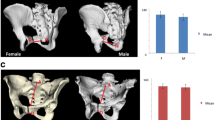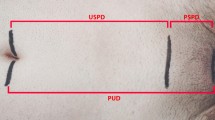Abstract
Purpose
The precise definition of the rectum is essential for localizing colorectal pathology, yet current definitions are nebulous. The objective of this study is to determine the anthropometric definition of common pelvic landmarks in relation to patient characteristics.
Methods
Seventy-one patients underwent open proctectomy with intra-operative measurements from the anal verge to various pelvic landmarks, and patient characteristics were evaluated. Analyses were performed using Spearman correlation and Wilcoxon rank sum.
Results
The mean landmark distance was dentate line = 1.7 cm (range 0.8–4.0 cm), puborectalis muscle = 4.2 cm (range 2.0–8.0 cm), anterior peritoneal reflection = 13.2 cm (range 8.5–21.0 cm), sacral promontory = 17.9 cm (range 13.0–26.0 cm), and confluence of the taenia = 25.5 cm (range 16.0–44.0 cm). Men had longer mean distances to the dentate line (p = 0.0003), puborectalis muscle (p = 0.03), and anterior peritoneal reflection (p = 0.02). Patient weight significantly correlated with distance to all landmarks except for the confluence of the taenia, which did not correlate with any patient factor.
Conclusions
The location of common pelvic landmarks is highly variable. The use of predefined absolute measurements from the anal verge to localize rectal pathology is inaccurate and fails to account for patient variability.
Similar content being viewed by others
References
Bagla N, Schofield JB (2007) Rectosigmoid tumours: should we continue sitting on the fence? Color Dis 9(7):606–8
Nelson H, Petrelli N, Carlin A, Couture J, Fleshman J, Guillem J, Miedema B, Ota D, Sargent D (2001) Guidelines 2000 for colon and rectal cancer surgery. J Natl Cancer Inst 93(8):583–96
Swedish Rectal Cancer Trial (1997) Improved survival with preoperative radiotherapy in resectable rectal cancer. N Engl J Med 336(14):980–7
Kapeteijn E, Marijnen C, Nagtegaal ID, Putter H, Steup WH, Wiggers T, Rutten HJ, Pahlman L, Glimelius B, van Krieken JH, Leer JW, van de Velde CJ (2001) Preoperative radiotherapy combined with total mesorectal excision for resectable rectal cancer. N Engl J Med 345(9):638–46
Mercury Study Group (2006) Diagnostic accuracy of preoperative magnetic resonance imaging in predicting curative resection of rectal cancer: prospective observational study. BJM 333(7572):779
Barleben A, Mills S (2010) Anorectal anatomy and physiology. Surg Clin N Am 90(1):1–15
Sauer R, Becker H, Hohenberger W, Rodel C, Wittekind C, Fietkau R, Martus P, Tschmelitsch J, Hager E, Hess CF, Karstens JH, Liersch T, Schmidberger J, Raab R (2004) Preoperative versus postoperative chemoradiotherapy for rectal cancer. N Engl J Med 351(17):1731–40
Kim SH, Park IJ, Joh YG, Hahn KY (2008) Laparoscopic resection of rectal cancer: a comparison of surgical and oncologic outcomes between extraperitoneal and intraperitoneal disease locations. Dis Colon Rectum 51(6):844–51
Schoellhammer HF, Gregorian AC, Sarkisyan GG, Petrie BA (2008) How important is rigid proctosigmoidoscopy in localizing rectal cancer? Am J Surg 196(6):904–8
Rödel C, Liersch T, Becker H, Fietkau R, Hohenberger W, Hothorn T, Graeven U, Arnold D, Lang-Welzenbach M, Raab HR, Sulberg H, Wittekind C, Potapov S, Staib L, Hess C, Weigang-Kohler K, Grabenbauer GG, Hoffmanns H, Lindemann F, Schlenska-Lange A, Folprecht G, Sauer R (2012) Preoperative chemoradiotherapy and postoperative chemotherapy with fluorouracil and oxaliplatin versus fluorouracil alone in locally advanced rectal cancer: initial results of the German CAO/ARO/AIO-04 randomised phase 3 trial. Lancet Oncol 13(7):679–87
Hwang MR, Park JW, Park S, Yoon H, Kim DY, Chang HJ, Kim SY, Park SC, Choi HS, Oh JH, Jeong SY (2014) Prognostic impact of circumferential resection margin in rectal cancer treated with preoperative chemoradiotherapy. Ann Surg Oncol 21(4):1345–51
Louis MA, Nandipati K, Astorga R, Mandava A, Rousseau CP, Mandava N (2010) Correlation between preoperative endoscopic and intraoperative findings in localizing colorectal lesions. World J Surg 34(7):1587–91
Piscatelli N, Hyman N, Osler T (2005) Localizing colorectal cancer by colonoscopy. Arch Surg 140(10):932–35
Keller DS, Paspulati R, Kjellmo A, Rokseth KM, Bankwitz B, Wibe A, Denaley CP (2014) MRI-defined height of rectal tumours. Br J Surg 101(2):127–32
Gordon PH, Nivatvongs S (2007) Principles and practice of surgery of the colon, rectum, and anus, 3rd edn. New York, Informa Healthcare USA, Inc
Gastrointestinal Tumor Study Group (1985) Prolongation of the disease-free interval in surgically treated rectal carcinoma. N Engl J Med 312(23):1465–72
Boulis-Wassif S, Gerard A, Loygue J, Camelot D, Buyse M, Duez N (1984) Final results of a randomized trial on the treatment of rectal cancer with preoperative radiotherapy alone or in combination with 5-fluorouracil, followed by radical surgery. Trial of the European organization on research and treatment of cancer gastrointestinal tract cancer cooperative group. Cancer 53(9):1811–8
Yun HR, Chun HK, Lee WS, Cho YB, Yun SH, Lee WY (2008) Intra-operative measurement of surgical lengths of the rectum and the peritoneal reflection in Korean. J Korean Med Sci 23(6):999–1004
Kim BN, Sohn DK, Hong CW, Han KS, Chang HJ, Jung KH, Lim SB, Choi HS, Jeong SY, Park JG (2008) Atypical endoscopic features can be associated with metastasis in rectal carcinoid tumors. Surg Endosc 22(9):1992–6
Rullier E, Denost Q, Vendrely V, Rullier A, Laurent C (2013) Low rectal cancer: classification and standardization of surgery. Dis Colon Rectum 56(5):560–7
Winter L, Bruhn H, Langrehr J, Neuhaus P, Felix R, Hanninen LE (2007) Magnetic resonance imaging in suspected rectal cancer: determining tumor localization, stage, and sphincter-saving resectability at 3-Tesla-sustained high resolution. Acta Radiol 48(4):379–87
Dobos N, Rubesin SE (2002) Radiologic imaging modalities in the diagnosis and management of colorectal cancer. Hematol Oncol Clin N Am 16(4):875–95
Furey E, Jhaveri KS (2014) Magnetic resonance imaging in rectal cancer. Magn Reson Imaging Clin N Am 22(2):165–90
Wittekind C, Greene F, Henson DE, Hutter RVP, Sobin LH (2003) TNM supplement: a commentary on uniform use, 4th edn. John Wiley & Sons, Hoboken
Beahrs OH, Myers MH (1977) The manual for staging of cancer, 2nd edn. J.B. Lippincott Company, Philadelphia
Compton CC, Byrd DR, Garcia-Aguilar J, Hurtzman SH, Olawaiya A, Washington MK (2012) Cancer staging atlas: a companion to the seventh editions of the AJCC cancer staging manual and handbook, 2nd edn. Springer, New York
Cataldo P, Schoetz DJ, Buess G (2009) Transanal endoscopic microsurgery: principles and techniques. Springer, New York
Najarian MM, Belzer GE, Cogbill TH, Mathiason MA (2004) Determination of the peritoneal reflection using intraoperative proctoscopy. Dis Colon Rectum 47(12):2080–5
Memon S, Keating JP, Cooke HS, Dennett ER (2009) A study into external rectal anatomy: improving patient selection for radiotherapy for rectal cancer. Dis Colon Retum 52(1):87–90
Thaler K, Baig MK, Berho M, Weiss EG, Nogueras JJ, Arnaud JP, Wexner SD, Bergamashi R (2003) Determinants of recurrence after sigmoid resection for uncomplicated diverticulitis. Dis Colon Rectum 46(3):385–8
Beck DE, Wexner SD, Hull TL, Roberts PL, Saclarides TJ, Senagore AJ, Stamos MJ, Porta R (2014) Anatomy and embryology of the colon, rectum, and anus, The ASCRS Textbook of Colon and Rectal Surgery. Springer, New York
Seike K, Koda K, Oda K, Kosugi C, Shimizu K, Miyazaki M (2009) Gender differences in pelvic anatomy and effects on rectal cancer surgery. Hepatogastroenterology 56(89):111–5
Kalfopulos BZ, Vargas SR, Camara EO, Correa VC, Sanchez AR (2012) Differences in pelvic parameters among Mexican, Caucasian, and Asian populations. J Neurosurg Spine 16:516–519
Kurki HK (2013) Bony pelvic canal size and shape in relation to body proportionality in humans. Am J Phys Anthropol 151:88–101
Yoshioka K, Matsui Y, Yamada O, Sakaguchi M, Takada H, Hioki K, Yamamoto M, Kitada M, Sawaragi I (1991) Physiologic and anatomic assessment of patients with rectocele. Dis Colon Rectum 34(8):704–708
Kenton K, Shott S, Brubaker L (1999) The anatomic and functional variability of rectoceles in women. Int Urogynecol J 10:96–99
Wagenlehner FME, Amo ED, Santoro GA, Petros P (2013) Live anatomy of the perineal body in patients with third-degree rectocele. Colorectal Dis 15:1416–1422
BBC News Health. Where are you on the global fat scale? [Internet] 2012 July 12 [updated 2012 Jul 12, cited 2014 Jun 18]. Available from: http://www.bbc.com/news/health-18770328#G1A24H1.58W42C167
Author information
Authors and Affiliations
Corresponding author
Ethics declarations
Ethics approval
This study was approved by the Institutional Review Board of Northwestern University (#STU00085178).
Rights and permissions
About this article
Cite this article
Wasserman, M.A., McGee, M.F., Helenowski, I.B. et al. The anthropometric definition of the rectum is highly variable. Int J Colorectal Dis 31, 189–195 (2016). https://doi.org/10.1007/s00384-015-2458-5
Accepted:
Published:
Issue Date:
DOI: https://doi.org/10.1007/s00384-015-2458-5




